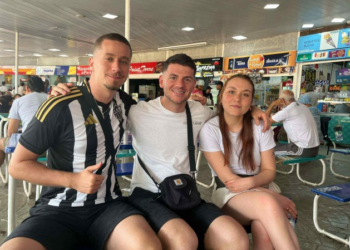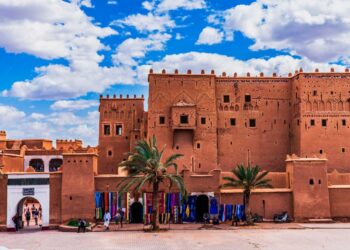[:pb]
Paris
The French capital has put a lot of energy into developing its urban beach and riverside culture; the Paris-Plages have been a feature on the banks of the Seine since 2002 and the city continues to build up its riverside as a destination every year. The latest opening is a luxury floating hotel Off Paris Seine, which began taking bookings in June and is on the opposite bank to Concrete, one of the city’sleading underground clubs, which opened on a boat in 2011. Further up the river is another one of Paris’s most popular cultural venues, Wanderlust, which has an outdoor and indoor nightclub and open-air cinema on its huge waterfront terrace. Of course, the artificial beaches, complete with 5,000 tonnes of sand, deck chairs and volleyball, are a huge draw for visitors. The main beach, the first to open, is a 3.5km strip between Pont Neuf and Pont de Sully. There are further beaches at Bassin de la Villette (close to metro Jaures/Stalingrad) and Voie Georges Pompidou. In 2013 the family-friendly Berges de la Seine park and promenade opened on the left bank – a fantastic eco-urban project – with kids’ playgrounds, alfresco bar and snooze boxes formed out of old shipping containers. Paris mayorAnne Hidalgo is aiming to allow swimming in the Seine – currently off-limits – by 2024. This year the beaches are open from 18 July until 21 August.
Berlin

For years the city has boasted one of the best urban beach scenes in the world, made up of countless bars along the Spree. The Strandbar Mitte bar is one of the oldest, with deckchairs, palm trees, and fresh pizza to enjoy with a bottle of beer. It’s one of the more easygoing spots, with dance classes in the evening followed by DJs. Other long-running beach bars include family-friendly African-Caribbean music venue, YAAM, which is the place for anyone seeking a sun-soaked, reggae-infused chill out; and riverside clubs, such as Club Der Visionaere, a cluster of canal-side shacks in Kreuzberg where you can enjoy techno beneath the shade of a huge weeping willow tree. From May to September you can cool off at Badeschiff, a stylish floating bathhouse and beach area where you can relax and enjoy some yoga or standup paddleboarding classes. Meanwhile, those who really want to cut loose on the Spree (and don’t mind looking a bit stupid to passersby) should rent a raft from Floss und Los and make their own floating barbecue party.
Gothenburg
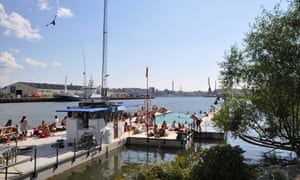
Sweden’s second city is well on its way to having an impressive urban beach of its own, comparable with Paris, thanks to the Jubilee park. It’s a development under way to coincide with the city’s 400-year celebrations in 2021, but the waterside project has already started opening up to the public, with a beach, sailing school, public bath and the city’s outdoor roller derby track (which is also used for yoga, oddly). The whole area is a fantastic, ambitious, architectural endeavour, with ideas of urban sustainability running through it; the sauna, for example, is made from recycled materials and the changing rooms built from 12,000 recycled glass bottles. Meanwhile in Stockholm, you can find a tranquil retreat in Långholmen Island – a green oasis that was the site of a prison until 1974. Now it’s a popular summer hangout, with beaches, open-air stages and a cafe. The prison is now theSTF Långholmen Hostel (room in dormitory from £25) – a great place to pitch up for a summer break in Stockholm if you want to punctuate exploring the city with swimming and sunbathing.
Brussels
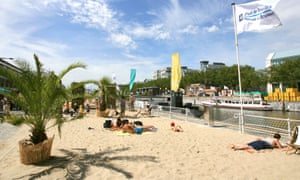
Belgium’s capital is another city that injects a taste of the riviera into its urban environment each year, with its Brussels Beach pop up. Running from July until early August the beach features a full schedule of events, from sand sculpture contests to club nights and outdoor cinema and opera. New additions for this year include a market selling surfing and other watersports gear, “Love Boat” speed dating, dancing courses and a book exchange. All this on a sandy promenade decked out with palm trees on the on the banks of the Brussels canal.
Vienna
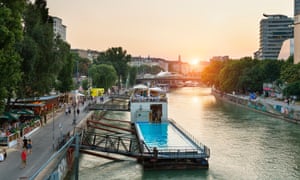
The focal point of Vienna’s summer scene is Danube island, a leafy 21km-long sliver of land in the eponymous river. There you’ll find sand, grass and gravel shores, including a family beach 250 metres in length as well as cafes, restaurants and bars and cycle and walking trails. While the island is set up for relaxation, those looking for more of a buzz should head to the Danube Canal and Strandbar Herrmann for that unbeatable combination of cocktails and deckchairs as well as live sports and club nights. Just along you’ll find the impressive Badeschiff, a unique club and bar on a rather big boat, with a floating pool attached to it and a big sun deck. Around that area of the canal you’ll find street food and pop-up restaurants – among them this year a gourmet burger grill called It’s All About the Meat Baby.
Copenhagen
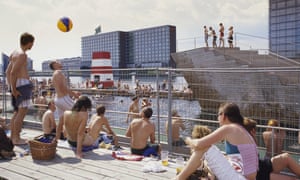
Perhaps not the first city that springs to mind for a summer bathing break, but the Danish capital has a number of beautifully designed harbour baths and urban beaches. There are four spots around the city where you can dive into the cool clear water: harbour bath Fisketorvet, which has earned the nickname Copencabana; the newest, the Coral Baths at Sluseholmen, which opened in 2011; and Svanemølle beach in the Østerbro district. But it’s the Islands Brygge baths that are perhaps the buzziest. Designed by star architect Bjarke Ingels, the baths have lawn space for sunbathing, barbecues and street food fans making it a hugely popular summer hang out. When you’re done drinking beer you can go for a dip in the 75-metre swimming pool beneath the Langebro bridge.
Amsterdam
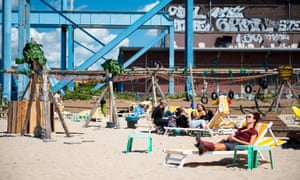
The coolest of the city’s urban beaches is perhaps Amsterdam Roest; a post-industrial space in the east of the centre, with a sandy beach dotted with art made from recycled junk. There’s also a huge market hall and throughout the summer the beach is a venue for film screenings and events. You’ll find similar vibes atBlijburg aan Zee a beachside venue on the eastern part of IJburg. Originally a pop-up summer space, the club, cafe and event space is a rustic hangout and, when the sun sets and the lanterns are lit, a magical place to spend a warm evening.
London
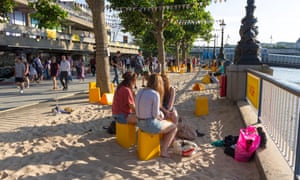
Eighty-five tonnes of sand aside, London’s Southbank Centre is already one of the best places to visit in the capital and with the impressive new Tate modern extension now open there’s never been a better year to make that leisurely stroll from the Royal Festival Hall to the Millennium bridge. During the summer the Southbank Centre comes into its own with an urban beach on the riverside promenade, part of the Festival of Love, which will see a big programme of free and outdoor events – including a performance space by Good Chance, a collective that early this year set up a theatre at the Calais Jungle – as well as ticketed shows. This year’s beach, however, is a Rio-themed affair, with caipirinhas and street food brought to you by Brazilian restaurant Cabana. Elsewhere in the capital, beach fun can be found everywhere from the roof of Camden’s Roundhouse to the huge Beach East at the Queen Elizabeth Olympic park, where 1,000 tonnes of sand are spread on the Stratford waterfront. Meanwhile, the beach at London Royal Docks, which launched four years ago is back for another year; an easygoing space with views towards the striking architecture that surrounds it.
Hamburg
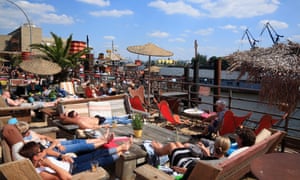
Berlin may have its fair share of urban beach bars but Germany’s second city has a very impressive scene of its own, which kicks off in spring when sand, sand and more sand gets shipped into Hamburg to get the party started. One of the main bars on the bank of the river Elbe is Strand Pauli, where straw-roofed wooden beach huts stand behind bamboo furniture and deckchairs, and cocktails can be sipped beneath a palm tree while enjoying dockland views. While Strand Pauli is a bit more grungy, Hamburg City Beach Club offers a slicker place to lounge. Meanwhile, if being by the water isn’t a prerequisite for you (this is an urban beach after all), then head to Central Park, a sand-floored venue in city centre, with ping pong, a bar and restaurant and a lively atmosphere in the evening.
Warsaw
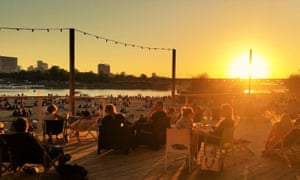
At night, when the lights of the Poniatowski bridge illuminate the river, Temat Rzeka – a venue on the bank of the Vistula – has one of the most atmospheric locations in the city. This chic bar, which opened three years ago as part of an effort to develop the already popular beach has a wooden decking area with sun loungers that runs regular club nights, as well as family events during the day and film screenings every Wednesday. It’s similar to Cud nad Wisłą, another beach bar on the opposite bank, which has been around since 2010; a venue with seating made from wooden pallets and a combination of club nights, performances and social events during the day. Further up the river you’ll find another city beach bar in the form of La Playa, a tropical club which hosts latin nights to go with your cocktail. During the day you’re welcome to hang out on the beach and play badminton, volleyball or frisbee. Beyond the Gdanski bridge, you’ll find Boogaloo Beach Bar. Like Temat Rzeka, it opened in 2013, creating a new party spot on the Żoliborz beach, with a Caribbean grill and regular reggae and dancehall parties.
Fonte: The Guardian[:]



